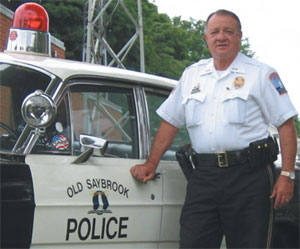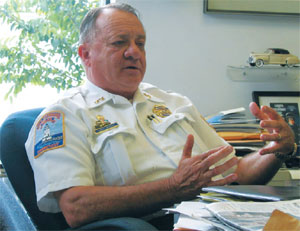Connecticut's Longest-Serving Police Chief Still Blazing Trails After 47 Years on the Job
| By JOHN C. PETERSON, Interim Editor |
If you knew what makes Connecticut’s longest serving police chief
tick, you might not be that surprised to see the potted tomato plants in
the solarium-like lobby of police headquarters.
 It’s been 36 years of the unusual for
Edmund H. Mosca as he has lead the Old
Saybrook Police Department, plus another
interesting 11 years as he rose quickly
through the ranks to become the state’s
then-youngest police chief at age 33.
It’s been 36 years of the unusual for
Edmund H. Mosca as he has lead the Old
Saybrook Police Department, plus another
interesting 11 years as he rose quickly
through the ranks to become the state’s
then-youngest police chief at age 33.
It started back in 1960 — what he calls
“the old days,” when he was a supernumerary
looking to supplement his day
job and support his growing family.
There was no formal training and no
requirements other than being ablebodied.
Tests and standards were a long
way off, and he thought the five dollars
he earned for babysitting a basketball
game or school dance was good money.
 Officers shared cars in those days, but
putting mileage on them was strongly
discouraged. Back then a red light that
hung on a Main Street pole was a signal
for officers to call the station. In those
days the phone also rang in the chief ’s
house, and he might respond if no one
else was available.
Officers shared cars in those days, but
putting mileage on them was strongly
discouraged. Back then a red light that
hung on a Main Street pole was a signal
for officers to call the station. In those
days the phone also rang in the chief ’s
house, and he might respond if no one
else was available.
International Recognition
Ed Mosca, like police work, has come
a long way. This year he will reach a new
high in his very distinguished career
when he’s sworn in for a three-year term
as vice president at-large of the International
Association of Chiefs of Police, a
group representing 22,000 members in 86
countries. It’s the first time anyone from
Connecticut has held office in that organization
in almost 60 years. That a chief
from a force of 22 sworn officers in a
quaint Connecticut town would rise to
this level is rare. But people who know Ed
Mosca know he can do big things.
The walls and shelves in his office are
testimony that Mosca has experienced a
great deal of “firsts” and made a lot of
history in his years as a chief. Autographed
photos of presidents, governors,
senators, congressmen, and high-ranking
law enforcement officials dot the
walls, along with letters from many of
them thanking him for his efforts and
acknowledging his expertise and accomplishments.
Were Those Really 'Good Old Days?'
Those "good old days" left a lot to be desired when you look
at the 47-year career of Ed Mosca, Connecticut’s longest-serving
police chief.
When he started there were no radios, and officers shared
cars. There was no Miranda warning to advise people of their
constitutional rights and no restricting search warrants. There
were no hiring standards or tests. Training was limited to
insights others on the force might share.
When he went to school right across the street from where
the police station stands today, there was no paid police force.
The population of the town was less than 3,000. State police
handled the town, and there was a constable who directed traffic
at the school. Interstate 95 had not been built. In the late
1950’s as the town grew and became a regional center, the
police department evolved to five officers, but there was no
daily full-time coverage.
Officers had a great deal of leeway as they enforced the law.
Each town had its own trial court which preceded the state’s
circuit court system.
Working conditions were difficult and dangerous. There
were no labor laws or unions, so officers would work 13 days
on and receive one day off. If your relief didn’t show for some
reason, you stayed working. That’s just the way it was.
The going rate for covering a dance or sporting event was
$5, and Mosca thought that was good money in those days.
Mosca was hired part-time as the sixth officer in 1960. The
next year, amid a controversy over whether the town’s second
traffic light should be installed, it was suggested the money
would be better spent if a full-time position was created. For
the same money, that officer was available for other coverage
when he wasn’t directing traffic.
“It was me or the traffic light,” Mosca quipped. He rose
quickly through the ranks. Detective in 1963, sergeant in 1966,
lieutenant in 1968, and in 1971, at age 33 with controversy
about his age, he became the youngest police chief in the state.
In the mid-1960’s things started to change. Standardized
training was created, and strict hiring requirements started to
evolve.Today the standards are so strict that departments have
a difficult time finding people who can endure the rigors of the
selection process.
Mosca has been at the front of much of that progress in
Connecticut, which he says has been a national leader in developing
high standards for police officers and their training.
“A better educated and more professional officer will make
better decisions, and that’s what we must strive to do,” Mosca
concluded.
|
The office also reflects plaques and
commendations noting the last 30 years
of service he has given to a variety of
state, national, and international associations—
committee work and key leadership
roles in organizations such as the
Law Enforcement Council of Eastern
Connecticut, Connecticut Police Chiefs
Association, and Police Association of
Connecticut. He’s been appointed by
four different governors to serve on a
variety of state initiatives, and he’s been
especially active on the Municipal Police
Training Council.
Nationally he’s been recognized as a
leading authority on law enforcement
and the needs of local police departments.
He has testified extensively at the
state level and has appeared before panels
of the U.S. House of Representatives
and the U.S. Senate. He also testified for
a U.S. Supreme Court nominee.
“Committed, dedicated passionate”
People who know him use words like
“committed,” “dedicated,” and “passionate”
to describe him. He’s a walking
encyclopedia of pending legislation at
the state and federal levels.
As a local chief he’s seen it all, including
what he calls the big one, the day
“unlike any other day.” That was the day
two years ago when two of his officers
were wounded in a shootout at a local
motel. One was shot in the head and the
other in the back and foot. While it was
a difficult time for him and the department,
it was also an event which underscored
his philosophy and convictions as
a police chief. “They were a product of
their training. Everyone performed the
way they were trained,” Mosca said.
 “You train for these incidents and
hope they never happen. But if they do,
you pray you get it right,” he explained.
In reconstructions of the shooting incident,
a variety of other law enforcement
agencies concurred the response of the
officers was textbook perfect.
“You train for these incidents and
hope they never happen. But if they do,
you pray you get it right,” he explained.
In reconstructions of the shooting incident,
a variety of other law enforcement
agencies concurred the response of the
officers was textbook perfect.
“My responsibility is to be sure they
are properly equipped and trained and
they’re as safe as they can be,” Mosca
added. The officers recovered and
returned to duty. The assailant recovered
from his wounds and accepted a plea
bargain for a 20-year sentence, a term
which Mosca called ridiculous, given the
circumstances of the incident and the
fact that the accused was a convicted
felon and career criminal with a long
history of violence.
“We have to be the best at what we do; I couldn’t live with it any other way,”
he said.
Longevity of chiefs tenuous
The longevity of police chiefs might
be tenuous at times and prompt some of them to be tactful and not rock the boat.
Whether the issue is lobbying for airconditioned
cars or arguing for power
windows in cruisers, that has not
stopped Mosca. A chief ’s responsibility
to the department and the community
demands that you do the right thing, no
matter how expensive or unpopular it
might be, he believes. While he
explains, a concrete truck passes through
the department’s driveway to contribute
its load to a new communications tower
at the rear of the property. It’s part of a
$2.6 million project that took six years to
pass. It will eliminate “dead spots” where
there is no coverage and will host a
townwide communication system for all
municipal agencies.
“No one wants to spend that kind of
money, but it was my job to show officials
and the voters it was necessary,”
Mosca added.
Forty-seven years of law enforcement
has given Mosca a front row seat
on life and the things people do to
themselves and each other. “I think I’ve
seen it all, a few times over,” he
observes, shaking his head. There have
been six homicides on his watch. One
that remains unsolved for 20 years still
dogs him. It involves a 20-year-old
woman whose body has never been
recovered. Department members are
convinced they have identified her
killer, but after traveling the country for
clues, they lack the evidence prosecutors
feel they need for a conviction.
Justice a two-way street
Mosca is proud of the talent and
experience that drives the Old Saybrook
Police Department and is quick to point
out the road of justice is a two-way
street. It’s important to solve crimes, but
it’s equally important to be sure innocent
people are not swept up in the process.
An example he cites happened several
years ago when a year-old child died,
and it appeared to be a clear case of
abuse. The circumstances were highly
unusual, and the activity of the adults
involved was questionable. It was a
highly emotional case, but as detectives
pursued the facts, they were able to
prove it was an unfortunate accident and
not a deliberate act.
“You feel good about those, too,”
Mosca commented. That personal satisfaction
from doing your job well and
helping people has been a tremendous
reward and a big part of Mosca’s career,
he says.
At 68 years old, Mosca plans to slow
down eventually, but not for a while. He
walks three and one-half miles before
work every day and has embarked on a
new weekend career of landscaping a
new home with two acres of needy lawn,
shrubs, and flowers. He was ready to
retire last year until he was recruited to
run for the vice presidency of the international
chiefs’ group. His wife and
town officials agreed it would be a great
opportunity for him and the town and
would also allow more time to develop
the next generation of management
within the department. He’s excited
about the opportunities ahead.
Proud of family
He says he’s proudest of his family.
He and his wife Dolores have five children
and 11 grandchildren who all live
nearby and keep him on the go with
their school and sports activities. He
tries hard not to miss any event, he says.
So what’s the story about the tomatoes
in the lobby? Every year the local
Garden Club decorates town buildings.
When discussing the plan for the police
department, someone joked about tomatoes.
Mosca said, “Hey, why not?”
“You wouldn’t expect to see that in a
police department, would you?” he quips
when asked why they occupy a prime
spot beside the doors.
So there they grow, straight and tall,
just like that communications tower and
so many other monuments to Ed
Mosca’s determination.
Chief Mosca Career Highlights
Old Saybrook Department of Police Services:
Joined Old Saybrook Police Department in 1960
Promoted to Detective in 1963
Promoted to Sergeant in 1966
Promoted to Lieutenant in 1968
Promoted to Chief in 1971
Graduate of the FBI National Academy 99th Session - 1974
State of Connecticut Gubernatorial Appointments:
Police Officers Standards and Training Council, 1995 to present Vice Chairman
Chair, Municipal Police Training Council, 1991
Acting Executive Director, MPTC, 1989 (10-Month Term)
Chair, Municipal Police Training Council, 1985
Municipal Police Training Council, 1980
Connecticut Justice Commission, 1978
Connecticut Communications Coordinating Committee, 1972-1973
New England Association of Chiefs of Police:
Host Chief, Annual Conference, 2001, 2007, 2008
Connecticut Police Chiefs Association:
Nominating Committee, 1984-1997
Legislative Committee, 1985-1993
Police Chiefs Selection Committee, 1986-1993
President, 1983
Critical Issues Committee Chairman, 1981-1985
Judicial Liaison Committee
Education Committee, 1979-1985
Police Association of Connecticut:
Executive Committee 1979 to present
Life member and permanent member
Treasurer 1979-1999.
Legislative Committee 1986-1999, Chairman
Law Enforcement Council of Eastern Connecticut:
Member 1979 to present
Served as Chairman for 3-year and 2-year terms
Awards, Recognitions, Community Accomplishments:
Longest serving police chief in the State of Connecticut
Middlesex County Bar Association Liberty Bell Award, 2003
Rotary Club's Paul Harris Fellowship Award, 2003
Old Saybrook Rotary Club President, 1980
Rotary Club, Active Member 1972 to present
|
|






